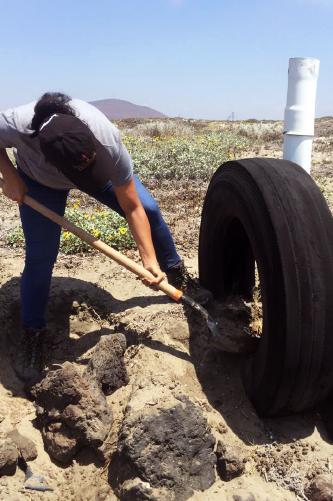
3 minute read
One Week as a Park Ranger
By Charlotte Vizuett
The work of the park rangers is one of those tasks that we imagine as a constant walk through trails with spectacular views in paradisiacal places. Although part of their activities are carried out in natural areas that they help protect, there is also the other part of the work, the one that is risky and requires attending visitors who don’t always know or respect the rules.
Advertisement
When I had the opportunity to participate in the “We are all park rangers” program in the summer of 2020, I was very excited to be able to support their work, as well as being outdoors and learning from their experiences.

Photo by Sofía Garduño.
The beginning of the day was marked by the coffee pot that we shared in the guardhouse, sending the radio report of how the night had been and if visitors had arrived. Between the cool wind and the mist, we carried coffee in the thermos while we did the morning tour, from the entrance of the Punta Mazo Nature Reserve to El Playon and back.
Sometimes when we returned from the tour there was nothing to report, other times we had observed an irregularity, and we had to take out the GPS to mark the location, take photos and send the report. Nature conservation also knows about bureaucracies and it’s necessary to keep a record.

Photo by Sofía Garduño.
The most complex tasks were the interactions with the visitors, particularly asking them to please follow the rules and recommendations. The vast majority of people who visit protected areas recognize the importance of their conservation, and the relationship that this has with the rules. However, this is not always the case. Once we saw someone riding an ATV on a path that is exclusively for pedestrians, and when we asked him to please not to do it, he left us talking to a cloud of dust.
An important part of the park rangers’ work is all the activities to maintain the infrastructure of the protected areas, the roads, the signs, the toilets, the trails. All this in addition to supporting visitors in case they have any questions or problems. The roads between the dunes are often deceptive, and often you think that you go to one place and end up in another, or the car gets stuck, and it’s the park rangers who help in those cases.

One day we took a tour of the Monte Ceniza Nature Reserve to check some points with the GPS, and we went up and down the volcano twice, with the sun on our back and the wind in our faces.
Another day we had to maintain the roads, and we carried volcanic stones to mark the boundary. At first, I was very confident when I believed my colleague Héctor when he said that since they were volcanic, they were bumpy and did not weigh. Although my back hurt, the goal was accomplished and the boundary was marked.

Photo by Terra Peninsular A.C.
Spending seven days as a park ranger allowed me to experience the challenges of their work and reaffirmed the deep respect I feel for all the people who dedicate their lives to the protection of natural areas. Thanks to their work there is a presence in the territory, and they are the first line of defense. Yes, working with the background landscape where the sea and the desert meet is a luxury, but dedicating one’s life to caring for the natural beauty is a commitment that gives our existence a purpose.

Photo by Terra Peninsular A.C.

Photo by Terra Peninsular A.C.










